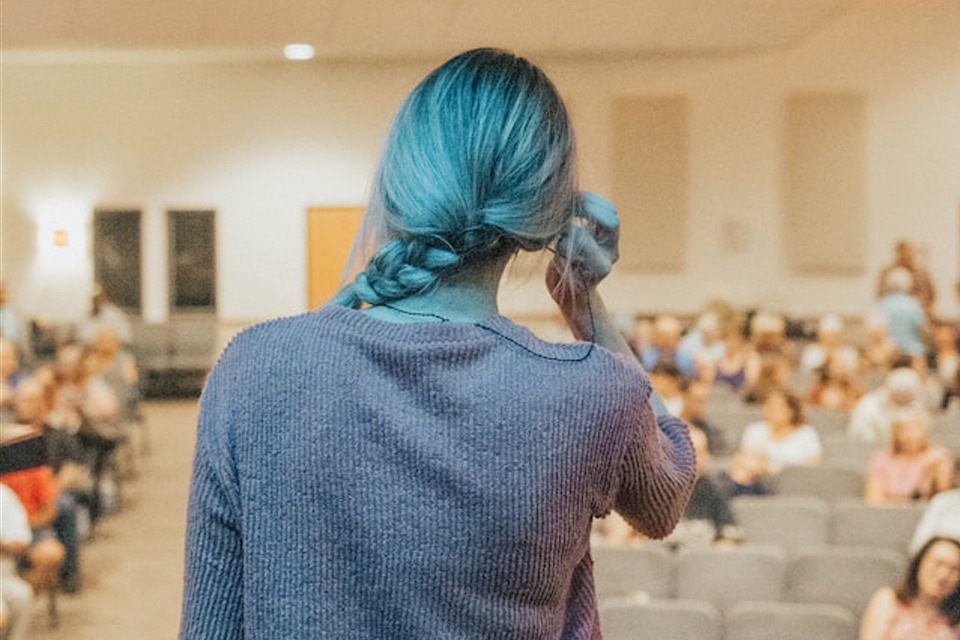Have you ever sat in a craft talk and felt it lacked something? The content was good, but fifteen minutes into the presentation, you find yourself scrolling through email on your phone. You’re bored, but you don’t know why.
Perhaps you’re having trouble focusing, or maybe it’s as simple as the speaker failed to connect with you from the start. As a writer, there is nothing like the moment you feel an emotional connection with another author, saying to yourself, “They’re like me!” or “I struggle with that too!” or “What a great idea!” In a world of rejection, suddenly, you don’t feel alone.
As writers, we let our words talk for us through the safety of the printed page or e-book. But sometimes, when we’re asked to deliver a craft talk, our words fall flat. The lights dim. We clip on a lapel mic and launch the discussion. But rather than receiving enthusiastic applause, we’re met with quiet claps or, worse yet, silence.
So, what does an emotional connection look like?
Let’s look at an example.
Mary led a craft talk on memoir writing. She opened by reading a section from her book about the United States adoption process, leading with facts and figures. While the audience wore sympathetic expressions, the room was silent.
Recognizing her mistake, Mary shifted to a passage from her parents’ viewpoint. “Imagine how my mother’s heart sank when the adoption agency said, ‘I’m sorry to tell you this, but there’s a problem with the adoption.’” The audience leaned forward and began to pay attention. Why? Because they related to the feelings of sadness and anxiety whether they were parents or not.
Here are a few tips to hook your audience from the start.
Know Who You’re Talking To
Tailoring your presentation to the desires of your audience can elevate their engagement. Ask yourself questions such as: Are the participants mostly new writers or established authors? Are they interested in literary fiction, non-fiction, or genre? What content benefits them the most?
Tell Them A Story
Like Mary’s adoption story told from her parents’ perspective, a personal story adds authenticity and makes you more personable and relatable.
Make it Funny
The easiest person to make fun of is yourself. Everyone has had an embarrassing moment or unexpected encounter with a stranger. People gravitate to life’s quirky details because they recognize themselves in the story or have been in a similar situation. That’s what makes it funny.
Plus, the best part about using a personal story is you’ve told it for years. You know where to expect a laugh.
Use Visuals
Choose visuals that align with your message. If you’re giving a craft talk on character emotions, such as calm or happiness, you might consider an image of a summer day by the ocean, with people sitting around a fire, using a blue and yellow color palate to evoke positive emotions.
Keep Your Body Language Open
Open body language makes you accessible to your audience. Standing firm with good posture, maintaining eye contact, and using open gestures emphasizes your words and punctuates your message in a meaningful way. And if nothing else, remember to smile!
Engage The Senses
Using sensory language is powerful. It appeals to the senses, allowing people to see, hear, taste, and feel your words as if they can taste the bitter coffee, see bright, colorful fireworks, or smell the floral notes of a perfume, creating an indelible imprint in the brain.
Use Repetition And Rhetorical Devices
Speakers often use repetition and rhetorical devices such as metaphors and analogies to make a presentation easier to follow and emphasize key points.
Repeated phrases carry a rhythmic quality, adding emphasis for the audience to remember key ideas. One of the greatest examples is Martin Luther King’s speech “I Had a Dream,” where the phrase “I had a dream” is repeated, and embedded metaphors and symbols create a greater understanding of slavery, segregation, and poverty.
Encourage Audience Participation
Lastly, encourage audience participation by asking questions like “How many of you have experienced…”
Record, Review, Revise
Before you give your craft talk or lecture, practice and record it on your phone to not only catch the filler words like “um” and “ah” but to ensure your content, word choice, and body language match your audience’s expectations.
[Photo by Ben Moreland on Unsplash]
********
Nanette Gamily is a crime fiction writer, a Regis University MFA graduate, and Tin House Residency finalist.



Thank you!